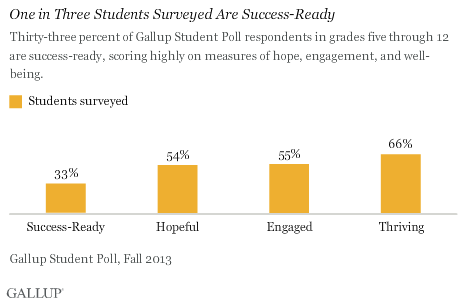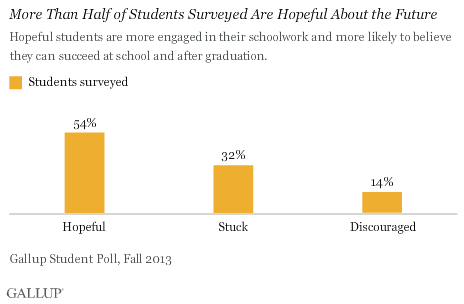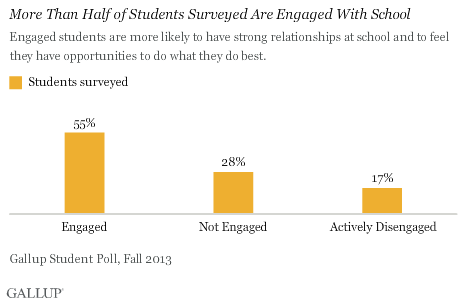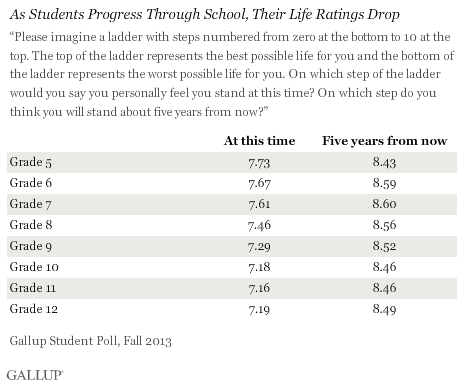Almost half of students surveyed in the U.S. lack hope for the future.
Most fifth- through 12th-grade students in the U.S. aren't success-ready. That's what the findings of Gallup's State of America's Schools report suggest. According to the Gallup Student Poll, only 33% of U.S. students surveyed in grades five through 12 are success-ready -- or hopeful, engaged, and with thriving well-being. Hope, engagement, and well-being are significantly related to student performance, influencing outcomes such as grades, credits earned, achievement scores, likelihood to stay in school, and future employment.

More than 600,000 students in grades five through 12 completed the Gallup Student Poll in fall 2013. Students from schools that elect to participate in the survey complete the online poll, which Gallup offers each year to public schools and school districts across the U.S. Though a large number of students take the poll each fall, the results aren't representative of the U.S. student population. But the results do offer an illuminating look at how more than half a million young people feel about the quality of their lives, their experiences at school, and their future.
While 54% of students surveyed in the U.S. are hopeful, almost half lack hope for the future, reporting they feel stuck in their lives (32%) or discouraged about the future (14%). Hopeful students take their education more seriously and bring positive ideas and energy to the learning process, making emotional engagement in school more likely.

A similar percentage of students are engaged with school (55%). But almost half are either not engaged (28%) or are actively disengaged (17%). Students' emotional engagement with school is the non-cognitive measure most directly related to academic achievement.

With each passing school year, students in the U.S. become less engaged -- making schools home to many psychological dropouts. Gallup finds a similar drop over time in student well-being. Gallup asks students to rate their current and future lives on a ladder scale with steps numbered from zero to 10 based on the Cantril Self-Anchoring Striving Scale. When asked to rank their position on a ladder of life, with the top of the ladder representing the best possible life and the bottom of the ladder representing the worst possible life, juniors in high school rate their current lives nearly one-half step lower than seventh-graders do.

Engaged teachers spread hope
Students in high school report that their days seem less interesting and more exhausting than younger students do. And over time, students' feelings of being treated with respect, interest in things at school, and energy decrease -- diminishing their overall quality of life.
However, having one teacher who instills excitement about the future can buffer students from hopelessness. About six in 10 students surveyed (58%) strongly agreed with the statement "I have at least one teacher who makes me excited about the future." Of these students, the majority (63%) qualify as hopeful, 70% are engaged with school, and 72% are considered to be thriving. On the other hand, among students who said they do not have a teacher who makes them excited about the future, 42% are hopeful, 35% are engaged, and 57% are thriving.
People who use their strengths every day report more positive emotions and an overall higher quality of life. In 2012, three in 10 teachers (31%) were engaged with their jobs. By focusing on teachers' strengths, schools can boost teacher engagement -- and in turn, student hope.
Encouraging student hope, engagement, and well-being
By encouraging all three predictors of student success -- hope, engagement, and well-being -- schools can help more students become success-ready. Schools can also encourage student engagement by helping students develop and use their strengths every day. Students who strongly agreed that their school is committed to building their strengths and that they have a teacher who makes them excited about the future are almost 30 times as likely to be engaged learners as their peers who strongly disagreed with both statements.
The pivotal role of teacher engagement in spreading student hope suggests that schools could benefit not only from focusing on teachers' strengths but also from hiring effective teachers who are capable of motivating students and encouraging student engagement. Gallup's research shows that students are best prepared for the rigors of life when they have high hopes for the future, are deeply involved in and enthusiastic about school, and feel emotionally and physically well enough to take advantage of learning opportunities.
Through developing students' strengths and promoting individualization, teachers can engage students in the learning process and build hope for the future. With increased student engagement comes deepened involvement and increased positive emotions -- encouraging enhanced overall student well-being and a higher quality of life.
Gallup Student Poll Methodology
Gallup offers its annual Gallup Student Poll at no cost to public schools and districts in the United States. The online poll is completed by a convenience sample of schools and districts each fall. These schools are not given any incentives beyond receipt of school-specific data. Participation rates vary by school. Gallup conducts the poll during a designated survey period, and it's available during school hours Tuesday through Friday only. Gallup administers the Gallup Student Poll to students in grades five through 12. In 2013, 616,203 students in U.S. schools participated in the Gallup Student Poll. The primary application of the Gallup Student Poll is as a measure of non-cognitive metrics that predict student success in academics and other youth development settings.

